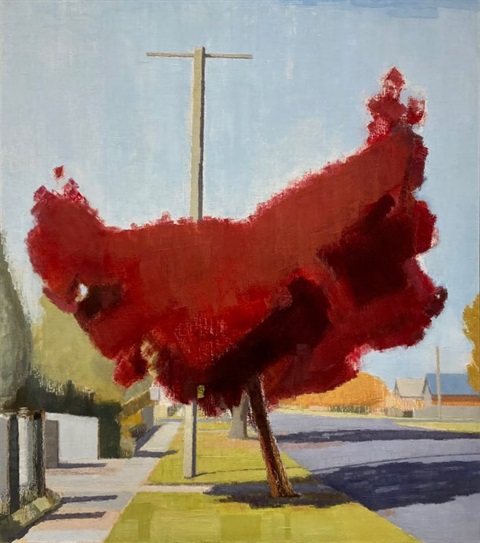CAL2021.1 Rachel Ellis

Title
Claret Ash, Bathurst
Location
In storage
Place of origin
Bathurst NSW, Australia
Year
2021
Media
Painting
Medium
oil on linen on plywood
Dimensions
139 x 122cm
Credit
Winner Calleen Art Award 2021
Accession number
CAL2021.1
On Rachel Ellis, by Peter Haynes (2022)
Rachel Ellis was born in 1967 in Adelaide. She studied at the (then) City Art Institute (now the University of New South Wales Art and Design) in Sydney, graduating in 1988 with a BA (Visual Arts). In 1991 she studied at the International School of Art, Montecastello, Vibio in Umbria, Italy, before returning to Sydney to study for an MA (Drawing) from 1992 to 1993. In 1998 she participated in a Summer School at the prestigious Slade School of Fine Art in London. Ellis has been exhibiting regularly in solo and group shows since 1994. Recent solo exhibitions include Sustaining Light, a survey exhibition held at the Bathurst Regional Art Gallery in 2018; Paintings and Drawings at King Street Gallery on William, Sydney (2012); and New Works at Cowra Regional Art Gallery (2011). She has participated in many group shows including most notably and on a number of occasions in the Blake Prize for Religious Art and the Dobell Drawing Prize.
Since receiving her MA Ellis has been the recipient of many prestigious awards and commissions including the Kedumba Art Award and the Waverley Woollahra Drawing Prize (both 1995); the Blake Prize for Religious Art (1996); the Marten Bequest Travelling Scholarship (1997); the Dr Denise Hickey Residency at the Cité Internationale des Arts, Paris (1998); the Communion of Saints commission for St Patrick’s Cathedral, Parramatta (2003-4); the Adelaide Perry Drawing Prize (2006); the Mosman Art Prize (2013); and the NSW Parliament Plein Air Painting Prize (2017). Ellis’s work is included in numerous collections including those of the Art Gallery of New South Wales, the NSW Parliament House, the Bathurst Regional Art Gallery, the Orange Regional Art Gallery, the University of Sydney and Macquarie Bank. The artist has lived and worked in Bathurst since 2001.
Claret Ash, Bathurst is a beautiful example of the artist’s consummate understanding of the formal and tonal qualities of light and her ability to imbue a sense of light’s universal presence, a presence that speaks of the spiritual character that is ubiquitous in Ellis’s approach to her art and life. The choice of subject – a suburban street in Bathurst – testifies to the richness the artist finds in her immediate surroundings. The titular tree has been physically reduced to allow for the carriage of powerlines (not visible In the work) to the street’s residences. The top section of the tree has been removed. The resultant form, characterised by a rhythmical organicism, stands in stark contrast to the spare geometries of the power poles and the receding lines of the grass path, the road and the houses that comprise the picture’s composition. The ash is a visually startling presence in its marvellously rich tonal structure and its placement as the chief pictorial protagonist in this deceptively simple construction. The tree’s form is delivered through an astutely realised series of tonal and formal contrasts that intimate rather than describe. The red of the tree is a dense configuration, a tonal density reinforced by the overall brightness of light that occupies the rest of the pictorial surface. That brightness is further underscored by the two dark shadows emanating from the tree and its unseen but nevertheless present neighbour to its rear. The shadows fall across the grey of the road; blatant areas of black that conversely indicate the ubiquitous presence of light that permeates this ostensibly simple paean to the concomitant power of the creative spirit and the forces that nourish it, Claret Ash is an exercise in visual and spiritual contemplation. The sense of stillness that permeates the work is reinforced by Ellis’s deliberate omission of human presence on the canvas. The artist’s presence though is quietly overt in this beautifully conceived ode to light and its sustaining presence.